The Historical Aspect of the Impact of Zn and Pb Ore Mining and Land Use on Ecohydrological Changes in the Area of the Biała Przemsza Valley (Southern Poland)
Abstract
1. Introduction
2. Materials and Methods
2.1. Climate and Hydrography
2.2. Geological Structure
2.3. Characteristics of Zn-Pb Ore Deposits
2.4. Hydrogeological Conditions
3. Results
3.1. Development of Zn and Pb Ore Mining in the Olkusz Region and Changes in Groundwater Circulation Conditions Caused by Mining Activity
3.2. Changes in Spatial Development
3.3. Changes in Water Chemistry
4. Discussion
4.1. Transformation of the Hydrological Conditions
4.2. Changes in Vegetation Cover as a Result of Impact of Zn and Pb ore Mining and Land Use
4.3. Changes in Water Chemistry as a Result of Development of Exploitation of Zn and Pb Ore Deposits
4.4. Use of Mine Water as an Element Influencing the Change in Hydrological Conditions and Water Management in the Catchment Area of Biała Przemsza
5. Conclusions
- Mining of Pb and Ag (later also Zn) ores in the Olkusz region began in the 11th century. After the construction of the Olkusz and Pomorzany Zn-Pb ore mines (from 1957 to 1975), regional drainage of the Triassic aquifer complex intensified (as of 1989, the maximum lowering of the water table was 150 m and the total area of the regional depression cone was 400 km2).
- The following trends in spatial development in the Biała Przemsza valley could be observed: rapid urbanisation and industrialisation in the 21st century, marked reduction in the surface area of arable land and sands, and dynamic growth of the surface area occupied by forests. The hydrographic network evolved.
- Between 1941 and 2021, vegetation ecosystems changed as a direct result of anthropogenic pressure. Lowering of groundwater levels due to mining activity resulted in a transformation from wet meadows to fresh or dry xerothermic grasslands. Forest cover increased (in 2021, it occupied 44% of the catchment area). The Błędowska Desert was devoid of vegetation until the 1930s; currently, its western part is forested, and sand grasslands appear on the loose sands.
- Changes in the hydrodynamic conditions have resulted in the diversity of the hydrogeochemical regime of the Triassic aquifer, which has been manifested by increased concentrations of, e.g., SO4 and Cl. The discharge of lignosulphonate compounds from the paper mill caused periodic degradation of part of the water flowing into the Pomorzany mine.
- As a result of mining activities, the Biała Przemsza River changed its character to an infiltrating one, a quantitative depletion of groundwater resources in the range of the depression cone of the mine drainage occurred, and there was a reduction in the flow of the Biała Przemsza River. At the same time, mine water was discharged into the Biała and Sztoła Rivers—tributaries of the Biała Przemsza. Further radical reduction in the flow of the Biała Przemsza and its tributaries occurred after the decommissioning of Zn-Pb ore mines and stopping the mine water discharge.
- Forecasted changes in surface water after the liquidation of the Olkusz Zn-Pb ore mines: ending of the Biała Przemsza water recharge with mine water flowing through the Biała and Sztoła rivers will result in restoration of natural water flow in the Biała Przemsza River, while water quality in the river will ultimately deteriorate (concentrations of, e.g., SO4 will increase).
Author Contributions
Funding
Institutional Review Board Statement
Informed Consent Statement
Data Availability Statement
Conflicts of Interest
References
- Cabała, J.; Warchulski, R.; Rozmus, D.; Środek, D.; Szełęg, E. Pb-Rich Slags, Minerals, and Pollution Resulted from a Medieval Ag-Pb Smelting and Mining Operation in the Silesian-Cracovian Region (Southern Poland). Minerals 2020, 10, 28. [Google Scholar] [CrossRef]
- Rahmonov, O.; Cabała, J.; Krzysztofik, R. Vegetation and Environmental Changes on Contaminated Soil Formed on Waste from an Historic Zn-Pb Ore-Washing Plant. Biology 2021, 10, 1242. [Google Scholar] [CrossRef] [PubMed]
- Cabała, J. Development of Oxidation in Zn-Pb Deposits in Olkusz Area. In Mineral Deposits at the Beginning of the 21st Century; Piestrzynski, A., Ed.; CRC Press: London, UK, 2001; pp. 121–124. [Google Scholar]
- Różkowski, A.; Wilk, Z. Warunki Hydrogeologiczne Złóż rud Cynku i Ołowiu Regionu Śląsko—Krakowskiego; Prace Instytutu Geologicznego: Warszawa, Poland, 1980. [Google Scholar]
- Motyka, J.; Adamczyk, Z.; Juśko, K. Dopływy wody do olkuskich kopalń rud cynku i ołowiu w ujęciu historycznym. Przegląd Górniczy 2016, 72, 49–58. [Google Scholar]
- Jabłońska-Czapla, M.; Nocoń, K.; Szopa, S.; Łyko, A. Impact of the Pb and Zn ore mining industry on the pollution of the Biała Przemsza River, Poland. Environ. Monit. Assess. 2016, 188, 262. [Google Scholar] [CrossRef] [PubMed]
- Ciszewski, D. Groundwater chemistry in a meander bend of the polluted Biała Przemsza river. Pol. J. Environ. Stud. 2019, 28, 1601–1611. [Google Scholar] [CrossRef]
- Kiryk, F.; Kołodziejczyk, R. Dzieje Olkusza i Regionu Olkuskiego; Oprac. zbiorowe (Vol. 2); Państ Wydaw. Naukowe PWN: Warszawa, Poland, 1978. [Google Scholar]
- Różkowski, A.; Chmura, A.; Siemiński, A. Użytkowe Wody Podziemne Górnośląskiego Zagłębia Węglowego i Jego Obrzeżenia; Prace Panstwoe Institut Geologiczne (PIG): Warszawa, Poland, 1997; Volume CLIX. [Google Scholar]
- Juśko, K.; Motyka, J.; d’Obyrn, K.; Adamczyk, Z. Construction of a numerical groundwater flow model in areas of intense mine drainage, as exemplified by the Olkusz Zinc and Lead Ore Mining Area in southwest Poland. Geologos 2018, 24, 237–244. [Google Scholar] [CrossRef]
- Różkowski, K. Wpływ Ucieczek Wody z Białej Przemszy na Zawodnienie Kopalni “Pomorzany”. Master’s Thesis, Faculty of Geol., Geof. i Ochr. Środow. AGH University of Science and Technology, Cracow, Poland, 1998. [Google Scholar]
- Haładus, A.; Motyka, J.; Szczepański, A.; Wilk, Z. Forecasting of ground-water inflow into mines in fissure-karst horizons Rusing the electric analogy simulation method. Ann. Soc. Geol. Pol. 1978, 48, 559–587. [Google Scholar]
- Adamczyk, Z.; Motyka, J. Rozwój dopływów wody do kopalń rud cynku i ołowiu w rejonie Olkusza. Przegląd Geol. 2000, 48, 171–175. [Google Scholar]
- Haładus, A.; Kulma, R. Schematyzacja złożonych warunków hydrogeologicznych dla prognozowania dopływów do kopalń na przykładzie rejonu olkuskiego. Gospod. Surowcami Miner. 2003, 19, 57–79. [Google Scholar]
- Motyka, J.; Różkowski, K. Preliminary research results of the consequences of water outflow from Biala Przemsza river on the total inflow to the Zn-Pb mine “Pomorzany”. In Proceedings of the XI Narodni Hydrogeologicky Kongres, Ostrava, Czech Republic, 2003; pp. 215–218. [Google Scholar]
- Haładus, A.; Kulma, R. Badania modelowe zmian stosunków wodnych w warunkach likwidacji górnictwa rud cynku i ołowiu w rejonie olkuskim. Gospod. Surowcami Miner. 2004, 20, 89–107. [Google Scholar]
- Kret, E.; Czop, M.; Pietrucin, D. Requirements for numerical hydrogeological model implementation for predicting the environmental impact of the mine closure based on the example of the Zn/Pb mines in the Olkusz area. In Proceedings of the 13th International Mine Water Association Congress—Mine Water & Circular Economy, Lappeenranta, Finland, 25–30 June 2017; Wolkersdorfer, C., Sartz, L., Sillanpää, M., Häkkinen, A., Eds.; Lappeenranta University of Technology: Lappeenranta, Finland, 2017; pp. 703–710. [Google Scholar]
- Wilk, Z.; Motyka, J. Kontakty hydrauliczne między poziomami wodonośnymi w olkuskim rejonie kopalnictwa rud [Contact between water-bearing horizons (Olkusz ore mining region near Cracow)]. Ann. Soc. Geol. Pol. 1977, 47, 115–143. [Google Scholar]
- Zdechlik, R.; Różkowski, K.; Śledzik, M. Influence of long-term mine activity on hydraulic relations between separate hydrogeological units—New aspects of regional water circulation assessment. Energies 2022, 15, 4647. [Google Scholar] [CrossRef]
- Adriano, D.C. Trace Elements in Terrestrial Environments; Springer Science and Business Media LLC: Berlin/Heidelberg, Germany, 2001; pp. 219–261. [Google Scholar]
- Aleksander-Kwaterczak, U.; Ciszewski, D. Pollutant dispersal in groundwater and sediments of gaining and losing river reaches affected by metal mining. Environ. Earth Sci. 2016, 75, 95. [Google Scholar] [CrossRef]
- El Hasnaoui, S.; Fahr, M.; Keller, C.; Levard, C.; Angeletti, B.; Chaurand, P.; Triqui, Z.E.A.; Guedira, A.; Rhazi, L.; Colin, F.; et al. Screening of native plants growing on a pb/Zn mining area in Eastern Morocco: Perspectives for phytoremediation. Plants 2020, 9, 1458. [Google Scholar] [CrossRef]
- Sanyaolu, V.; Adeniran, A. Determination of heavy metal fallout on the surrounding flora and aquifer: Case study of a scrap metal smelting factory in Odogunyan Area, Ikorodu, Lagos-State, Nigeria. Int. Res. J. Environ. Sci. 2014, 3, 93–100. [Google Scholar]
- Rahmonov, O.; Krzysztofik, R.; Środek, D.; Smolarek-Lach, J. Vegetation- and environmental changes on non-reclaimed spoil heaps in southern Poland. Biology 2020, 9, 164. [Google Scholar] [CrossRef]
- Rahmonov, O.; Snytko, V.A.; Szczypek, T.; Parusel, T. Vegetation development on post-industrial territories of the Silesian Upland (Southern Poland). Geogr. Nat. Resour. 2013, 34, 96–103. [Google Scholar] [CrossRef]
- Szarek-Łukaszewska, G. Vegetation of reclaimed and spontaneously vegetated Zn-Pb mine wastes in southern Poland. Pol. J. Environ. Stud. 2009, 18, 717–733. [Google Scholar]
- Lock, K.; Janssens, F.; Janssen, C. Effects of metal contamination on the activity and diversity of springtails in an ancient Pb-Zn mining area at Plombières, Belgium. Eur. J. Soil Biol. 2003, 39, 25–29. [Google Scholar] [CrossRef]
- Baker, A.J.M.; Ernst, W.H.O.; van der Ent, A.; Malaisse, F.; Ginocchio, R. Metallophytes: The Unique Biological Resource, Its Ecology and Conservational Status in Europe, Central Africa and Latin America; Batty, L.C., Hallberg, K.B., Eds.; Cambridge University Press, British Ecological Safety: Cambridge, UK, 2012; pp. 7–40. [Google Scholar]
- Monterroso, C.; Rodriguez, F.; Chaves, R.; Diez, J.; Becerra-Castro, C.; Kidd, P.S.; Macias, F. Heavy metal distribution in mine-soils and plants growing in a Pb/Zn-mining area in NW Spain. Appl. Geochem. 2014, 44, 3–11. [Google Scholar] [CrossRef]
- Miller, M.; Gosar, M. Characteristics and potential environmental influences of mine waste in the area of the closed Mežica Pb–Zn mine (Slovenia). J. Geochem. Explor. 2012, 112, 152–160. [Google Scholar] [CrossRef]
- Žibret, G.; Gosar, M.; Miler, M.; Alijagić, J. Impacts of mining and smelting activities on environment and landscape degradation—Slovenian case studies. Land Degrad. Dev. 2018, 29, 4457–4470. [Google Scholar] [CrossRef]
- Zhan, H.Y.; Jiang, Y.F.; Yuan, J.M.; Hu, X.F.; Nartey, O.D.; Wang, B.L. Trace metal pollution in soil and wild plants from lead–zinc smelting areas in Huixian County, Northwest China. J. Geochem. Explor. 2014, 147, 182–188. [Google Scholar] [CrossRef]
- Zhu, G.; Xiao, H.; Guo, Q.; Song, B.; Zheng, G.; Zhang, Z.; Zhao, J.; Okoli, C.P. Heavy metal contents and enrichment characteristics of dominant plants in wasteland of the downstream of a lead-zinc mining area in Guangxi, Southwest China. Ecotoxicol. Environ. Saf. 2018, 151, 266–271. [Google Scholar] [CrossRef]
- Midhat, L.; Ouazzani, N.; Hejjaj, A.; Ouhammou, A.; Mandi, L. Accumulation of heavy metals in metallophytes from three mining sites (Southern Centre Morocco) and evaluation of their phytoremediation potential. Ecotoxicol. Environ. Saf. 2019, 169, 150–160. [Google Scholar] [CrossRef]
- Czaja, S.; Rahmonov, O.; Wach, J.; Gajos, M. Ecohydrological Monitoring in Assessing the Mining Impact on Riverside Ecosystems. Pol. J. Environ. Stud. 2014, 23, 629–637. [Google Scholar]
- Rahmonov, O.; Dragan, W.; Cabała, J.; Krzysztofik, R. Long-Term Vegetation Changes and Socioeconomic Effects of River Engineering in Industrialized Areas (Southern Poland). Int. J. Environ. Res. Public Health 2023, 20, 2255. [Google Scholar] [CrossRef] [PubMed]
- Tordoff, G.; Baker, A.; Willis, A. Current approaches to the revegetation and reclamation of metalliferous mine wastes. Chemosphere 2000, 41, 219–228. [Google Scholar] [CrossRef] [PubMed]
- Venkateswarlu, K.; Nirola, R.; Kuppusamy, S.; Thavamani, P.; Naidu, R.; Megharaj, M. Abandoned metalliferous mines: Ecological impacts and potential approaches for reclamation. Rev. Environ. Sci. Bio Technol. 2016, 15, 327–354. [Google Scholar] [CrossRef]
- Prach, K.; Pyšek, P. Using spontaneous succession for restoration of human-disturbed habitats: Experience from Central Europe. Ecol. Eng. 2001, 17, 55–62. [Google Scholar] [CrossRef]
- Sheoran, V.; Sheoran, A.S.; Poonia, P. Soil reclamation of abandoned mine land by revegetation: A review. Int. J. Soil Sediment Water 2010, 3, 2. [Google Scholar]
- Yang, S.-X.; Liao, B.; Yang, Z.-H.; Chai, L.-Y.; Li, J.-T. Revegetation of extremely acid mine soils based on aided phytostabilization: A case study from southern China. Sci. Total Environ. 2016, 562, 427–434. [Google Scholar] [CrossRef] [PubMed]
- Broadley, M.R.; White, P.J.; Hammond, J.P.; Zelko, I.; Lux, A. Zinc in plants. New Phytol. 2007, 173, 677–702. [Google Scholar] [CrossRef] [PubMed]
- Stefanowicz, A.M.; Stanek, M.; Woch, M.W.; Kapusta, P. The accumulation of elements in plants growing spontaneously on small heaps left by the historical Zn-Pb ore mining. Environ. Sci. Pollut. Res. 2016, 23, 6524–6534. [Google Scholar] [CrossRef] [PubMed]
- Cabała, J.; Sutkowska, K. Wpływ dawnej eksploatacji i przeróbki rud Zn-Pb na skład mineralny gleb industrialnych, rejon Olkusza i Jaworzna. Prace Naukowe Instytutu Górnictwa Politechniki Wrocławskiej. Stud. IMater. 2006, 117, 13–22. [Google Scholar]
- Cappuyns, V.; Swennen, R.; Devivier, A. Dredged river sediments: Potential chemical time bombs? A case study. Water Air Soil Pollut. 2006, 171, 49–66. [Google Scholar] [CrossRef]
- Merrington, G.; Alloway, B.J. The transfer and fate of Cd, Cu and Zn from two historic metalliferous mine sites in the UK. Appl. Geochem. 1994, 9, 677–687. [Google Scholar] [CrossRef]
- Mapa Szczegółowa Polski 1:25000, Arkusze: P47-S29-A Zawiercie, P47-S29-B Ogrodzieniec, P47-S29-C Chlina, P47-S29-D Błędów, P47-S29-E Klucze, P47-S29-F Wolbrom, P47-S29-G Sławków, P47-S29-H Olkusz, P47-S29-I Sułoszowa; Wojskowy Instytut Geograficzny: Warszawa, Poland, 1935.
- Mapa Obrębowa Powiatów 1:25000, Arkusze: Powiat Olkusz. Województwo Krakowskie(Arkusze: 3, 4, 6, 7); Powiat Zawiercie. Województwo Katowickie (Arkusz 5); Zarząd Topograficzny Sztabu Generalnego: Warszawa, Poland, 1961.
- Mapa Topograficzna 1:50000, arkusze: M-34-51-D Zawiercie, M-34-52-C Ogrodzieniec, M-34-63-B Jaworzno, M-34-64-A Olkusz; Główny Geodeta Kraju: Warszawa, Poland, 1993–1996.
- Open-Access Regional Spatial Information System–ORSIP. Available online: https://www.mapy.orsip.pl (accessed on 21 February 2023).
- Zakład Górniczo-Hutnicze (ZGH) Bolesław. Materiały Archiwalne i Niepublikowane; Zakład Górniczo-Hutnicze (ZGH) Bolesław: Bolesław, Polska, 2023. [Google Scholar]
- Woś, A. Klimat Polski w Drugiej Połowie XX Wieku; Wydawnictwo Naukowe Poznań: Poznań, Poland, 2010. [Google Scholar]
- Kondracki, J. Geografia regionalna Polski; Państwowe Wydawnictwo Naukowe, PWN: Warszawa, Poland, 1998. [Google Scholar]
- Punzet, J. Bilans Wodny Górnośląskiego Okręgu Przemysłowego; Prace Państwowy Instytut Hydrologiczno-Meteorologiczny (PIHM): Warszawa, Poland, 1959; Volume 49. [Google Scholar]
- Motyka, J.; Wilk, Z. Pionowe zróżnicowanie wodoprzepuszczalności węglanowych skał triasowych w świetle statystycznej analizy wyników prónych pompowań (monoklina śląsko-krakowska). Geol. Q. 1976, 20, 281–400. [Google Scholar]
- Wilk, Z.; Motyka, J. Zasobność wodna szczelinowo-krasowych utworów wschodniej części monokliny śląsko-krakowskiej. Ann. Soc. Geol. Pol. 1980, 50, 447–484. [Google Scholar]
- Pierzak, J.; Rozmus, D.; Roś, J. Wyniki badań ratowniczych na późnośredniowiecznej osadzie produkcyjnej w Hutkach k. Olkusza. W: “Badania Archeologiczne na Górnym Śląsku i ziemiach pogranicznych w roku 1998”. Katowice, 2001, 193–204. Available online: https://knihovna.muzeumct.cz/records/cc7dfb7c-1019-4a5d-8b93-b070f634e81f (accessed on 27 April 2023).
- Liszka, J.; Świć, E. Zakłady Górniczo-Hutnicze “Bolesław. Dzieje Wydarzenia Ludzie; Zakłady Górniczo-Hutnicze “Bolesław” SA: Bukowno, Poland, 2013. [Google Scholar]
- Włodarz, B. Zabytkowa kopalnia górnictwa kruszcowego w Olkuszu-perspektywy uruchomienia. Górnictwo Geoinżynieria 2006, 30, 131–141. [Google Scholar]
- Wilk, Z.; Bocheńska, T. Hydrogeologia Polskich Złóż Kopalin i Problemy Wodne Górnictwa; Vol. 2 AGH; Uczelniane Wydawnictwa Naukowo-Dydaktyczne: Kraków, Poland, 2013. [Google Scholar]
- Adamczyk, A.F. Cynk i Ołów w Wodach Dołowych Kopalń Rejonu Olkuskiego; Praca doktorska, Biblioteka AGH: Kraków, Poland, 1979. [Google Scholar]
- Szczypek, T.; Wach, J.; Wika, S. Zmiany Krajobrazów Pustyni Błędowskiej; Wydział Nauk o Ziemi Uniwersytetu Śląskiego: Sosnowiec, Poland, 1994. [Google Scholar]
- Rahmonov, O.; Oleś, W.W. Vegetation succession over an area of a medieval ecological disaster. The case of the Błędów Desert, Poland. Erdkunde 2010, 64, 241–255. [Google Scholar] [CrossRef]
- Klukanová, A.; Rapant, S. Impact of mining activities upon the environment of the Slovak Republic: Two case studies. J. Geochem. Explor. 1999, 66, 299–306. [Google Scholar] [CrossRef]
- Wu, C.; Wu, X.; Zhu, G.; Qian, C. Predicting mine water inflow and groundwater levels for coal mining operations in the Pangpangta coalfield, China. Environ. Earth Sci. 2019, 78, 1–13. [Google Scholar] [CrossRef]
- Rahmonov, O.; Rozkowski, J.; Szymczyk, A. Is the Vegetation Succession a Threat for Rare and Protected Species in a Sand Quarry? Case Study of the Kuźnica Warężyńska Sand Quarry (Southern Poland). IOP Conf. Ser. Earth Environ. Sci. 2019, 362, 012010. [Google Scholar] [CrossRef]
- Różkowski, J.; Rahmonov, O.; Szymczyk, A. Environmental Transformations in the Area of the Kuźnica Warężyńska Sand Mine, Southern Poland. Land 2020, 9, 116. [Google Scholar] [CrossRef]
- Rahmonov, O.; Różkowski, J.; Klys, G. The Managing and Restoring of Degraded Land in Post-Mining Areas. Land 2022, 11, 269. [Google Scholar] [CrossRef]
- Rahmonov, O. Development and functioning of riparian ecosystem (Fraxino-Alnetum) under the influence of human impact. In Environmental Engineering, Proceedings of the International Conference on Environmental Engineering (ICEE), Vilnius, Lithuania, 22–23 May 2014; Vilnius Gediminas Technical University: Vilnius, Lithuania, 2014; pp. 1–6. [Google Scholar] [CrossRef]
- Okuniewska-Nowaczyk, I.; Rahmonov, O.; Snytko, V.A.; Szczypek, T. Palynological record of the history of vegetation in the sandy areas of southern Poland. Geogr. Nat. Resour. 2018, 39, 396–402. [Google Scholar] [CrossRef]
- Timan, D. The resource ratio hypothesis of succession. Am. Nat. 1988, 125, 827–852. [Google Scholar] [CrossRef]
- Mróz, W.; Baba, W. Monitoring of Natural Habitats, Metodological Quide for 5 Natural Habitats: 3110, 6210, 6520, 7230 and 9180; Library of Environmental Monitoring: Warszawa, Poland, 2013. [Google Scholar]
- Rahmonov, O.; Rozkowski, J.; Szymczyk, A. Relationship between compositions of grey hair-grass (Corynephorus canescens (L.) P. Beauv.) tissues and soil properties during primary vegetation succession. IOP Conf. Ser. Earth Environ. Sci. 2019, 362, 012009. [Google Scholar] [CrossRef]
- Rahmonov, O.; Snytko, V.A.; Szczypek, T. Influence of Melioration in Natural Ecological Processes of a Small River Valley (Poland). Geogr. Nat. Res. 2016, 37, 379–384. [Google Scholar] [CrossRef]
- Ciszewski, D.; Kucha, H.; Skwarczek, M. Authigenic minerals and sediments in the hyporheic zone of the Biała Przemsza River polluted by metal ore mining. Przegl. Geol. 2017, 65, 650–660. [Google Scholar]
- Jabłońska-Czapla, M. Antimony, Arsenic and Chromium Speciation Studies in Biała Przemsza River (Upper Silesia, Poland) Water by HPLC-ICP-MS. Int. J. Environ. Res. Public Health 2015, 12, 4739–4757. [Google Scholar] [CrossRef] [PubMed]
- Ciszewski, D.; Bijata, P. Hyporheic zone hydrochemistry of the mine-polluted river. J. Geosci. Environ. Prot. 2015, 3, 47–52. [Google Scholar] [CrossRef]
- Rahmonov, O.; Czajka, A.; Nádudvari, Á.; Fajer, M.; Spórna, T.; Szypuła, B. Soil and Vegetation Development on Coal-Waste Dump in Southern Poland. Int. J. Environ. Res. Public Health 2022, 19, 9167. [Google Scholar] [CrossRef] [PubMed]
- Silesian Vojevodship. Available online: https://slaskie.naszemiasto.pl (accessed on 15 March 2023).
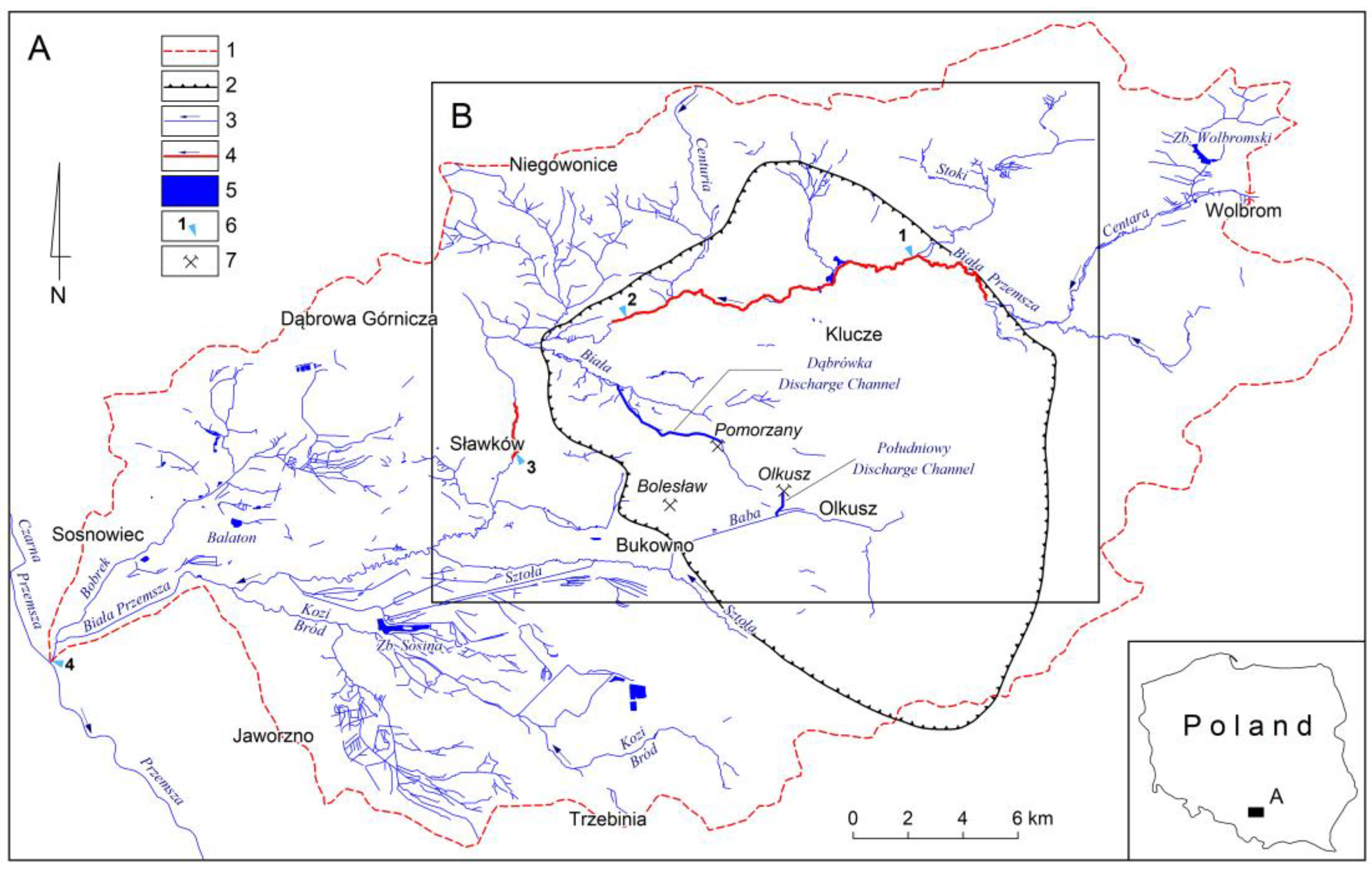
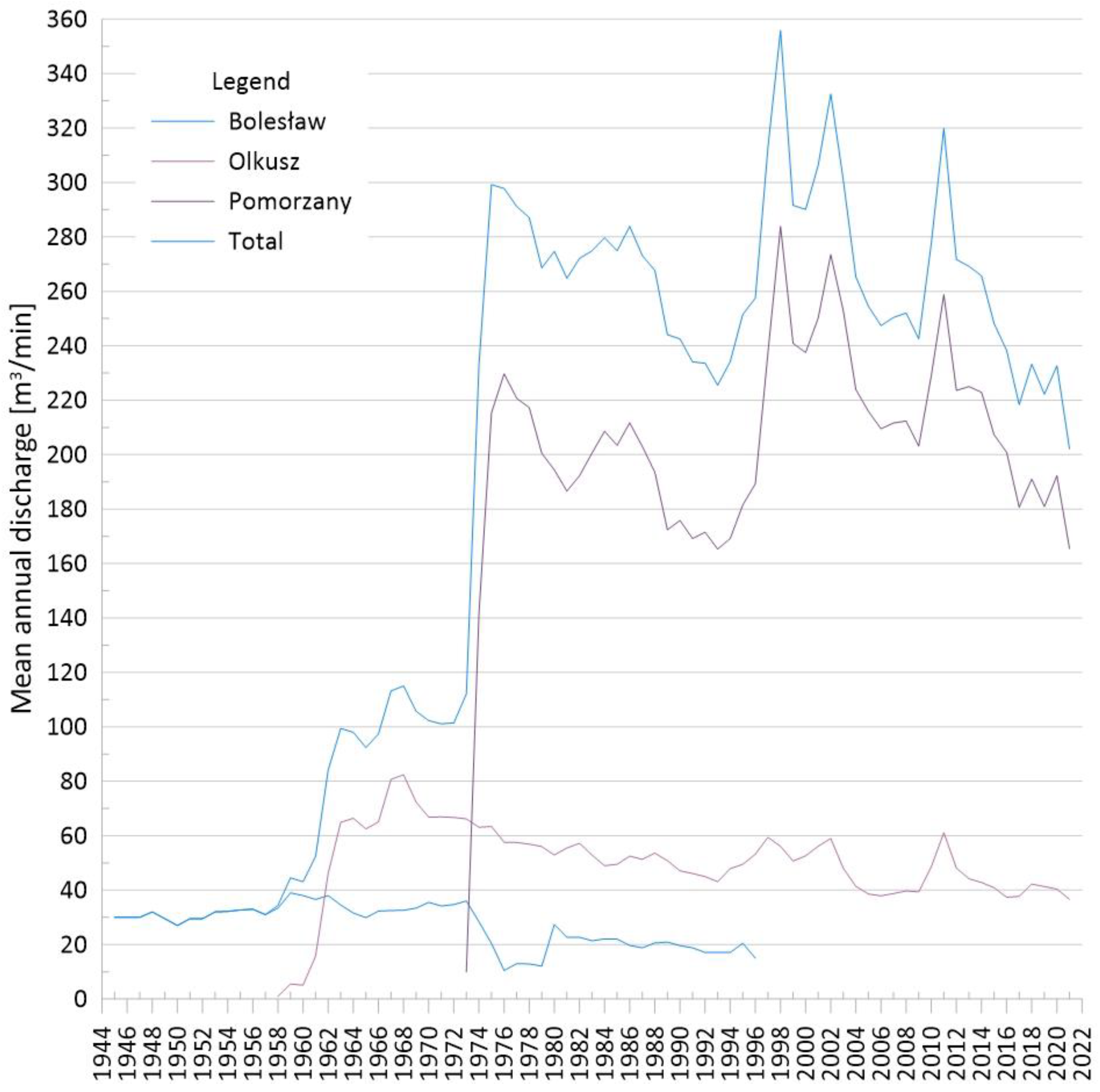
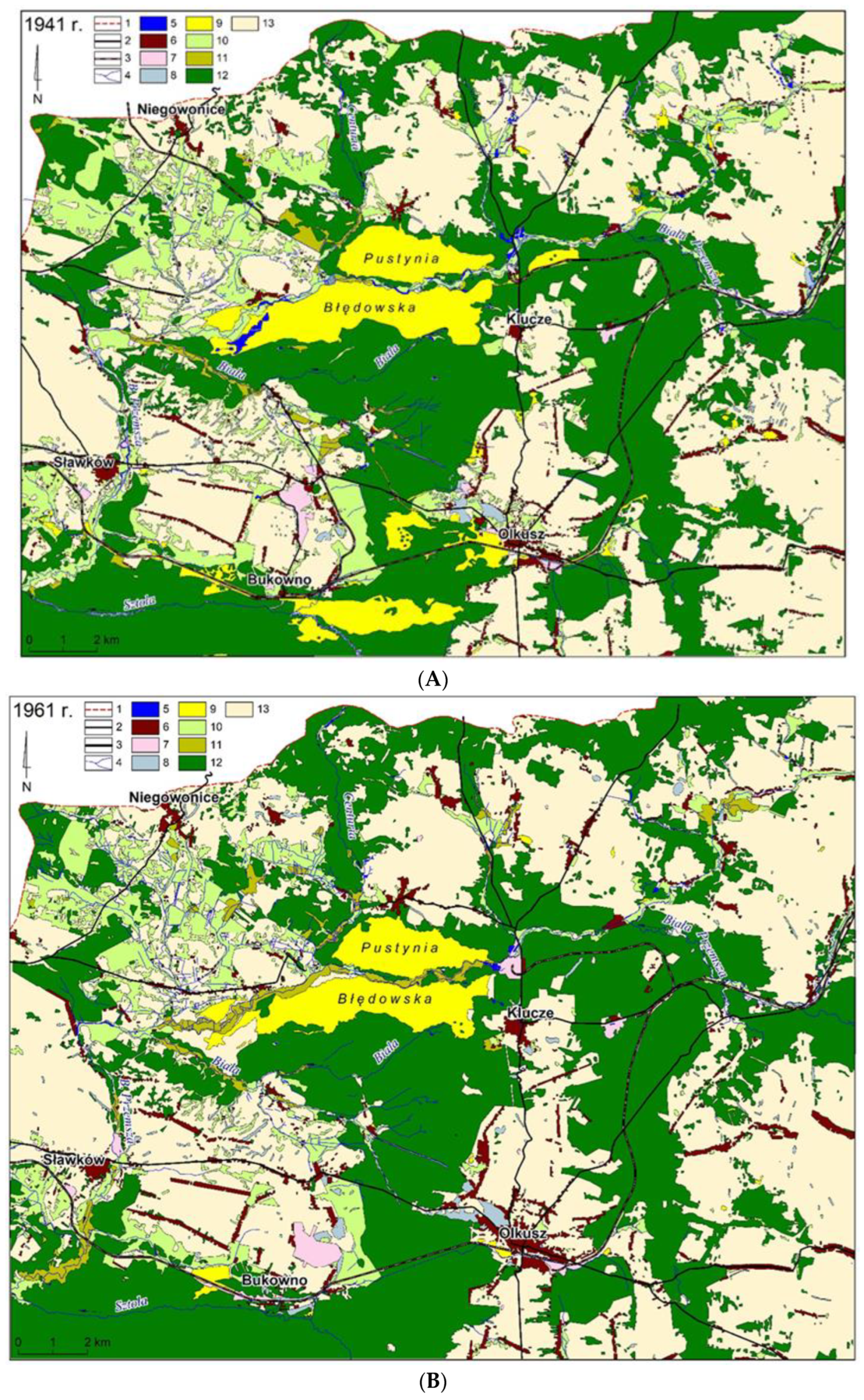
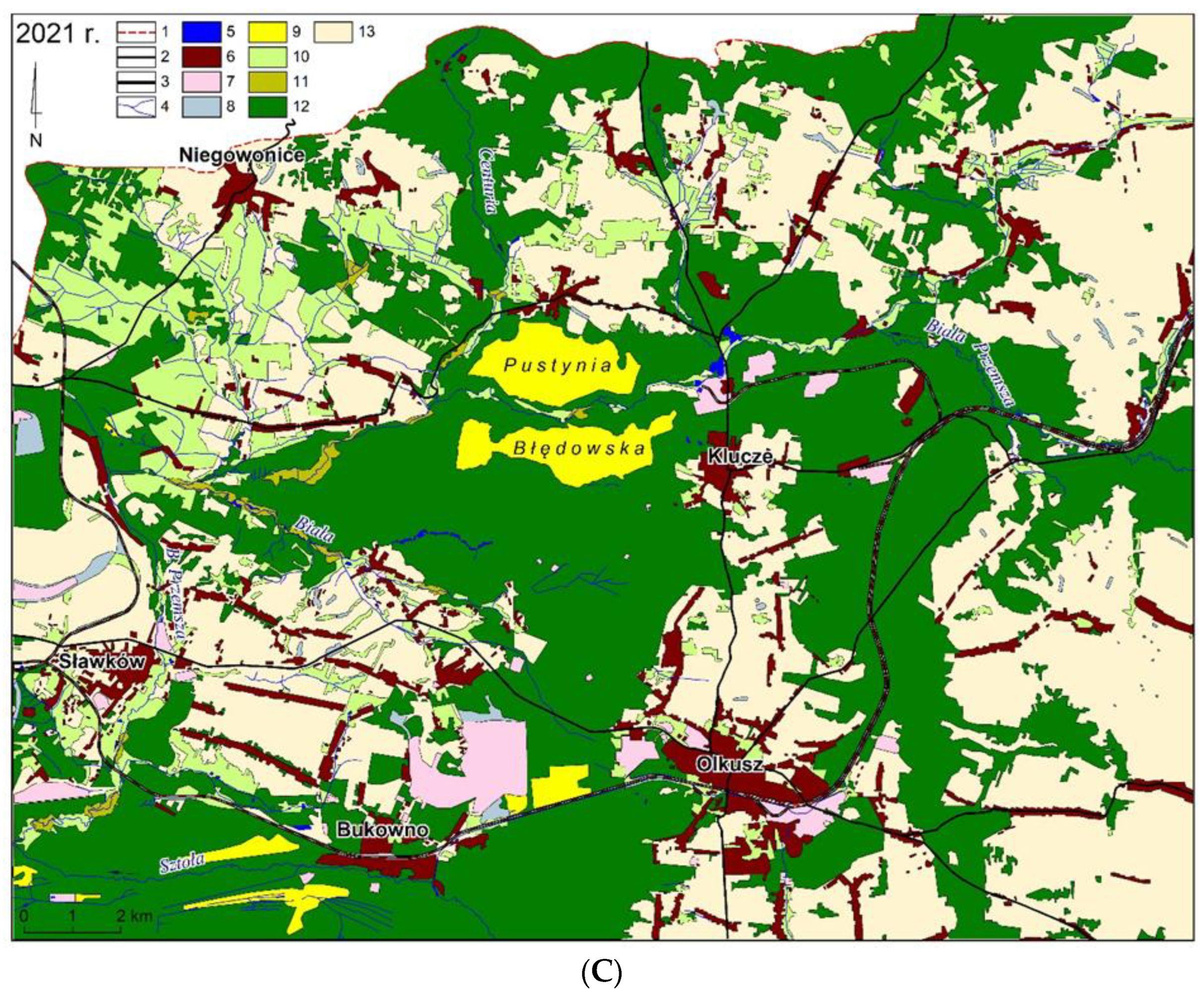
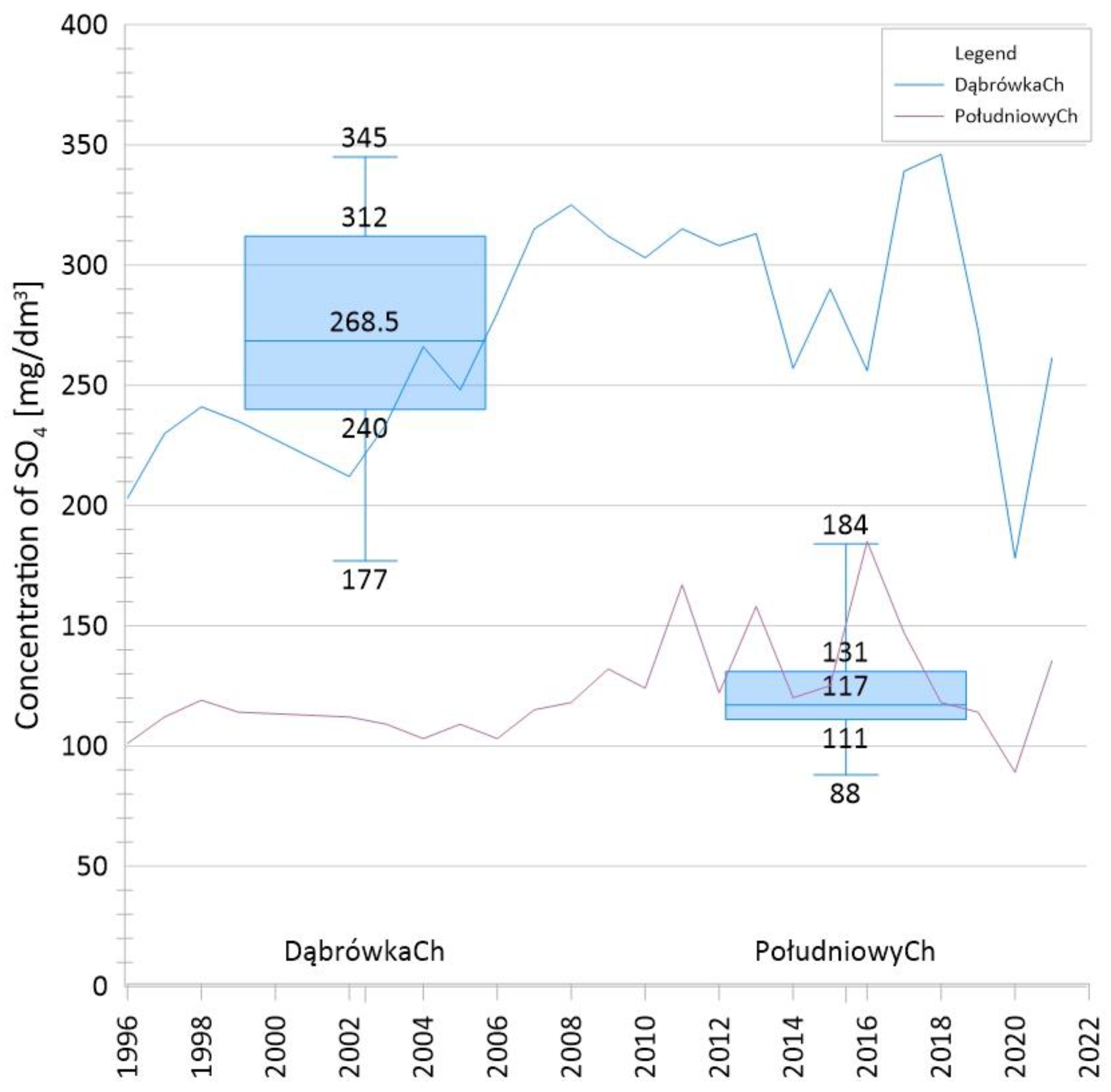
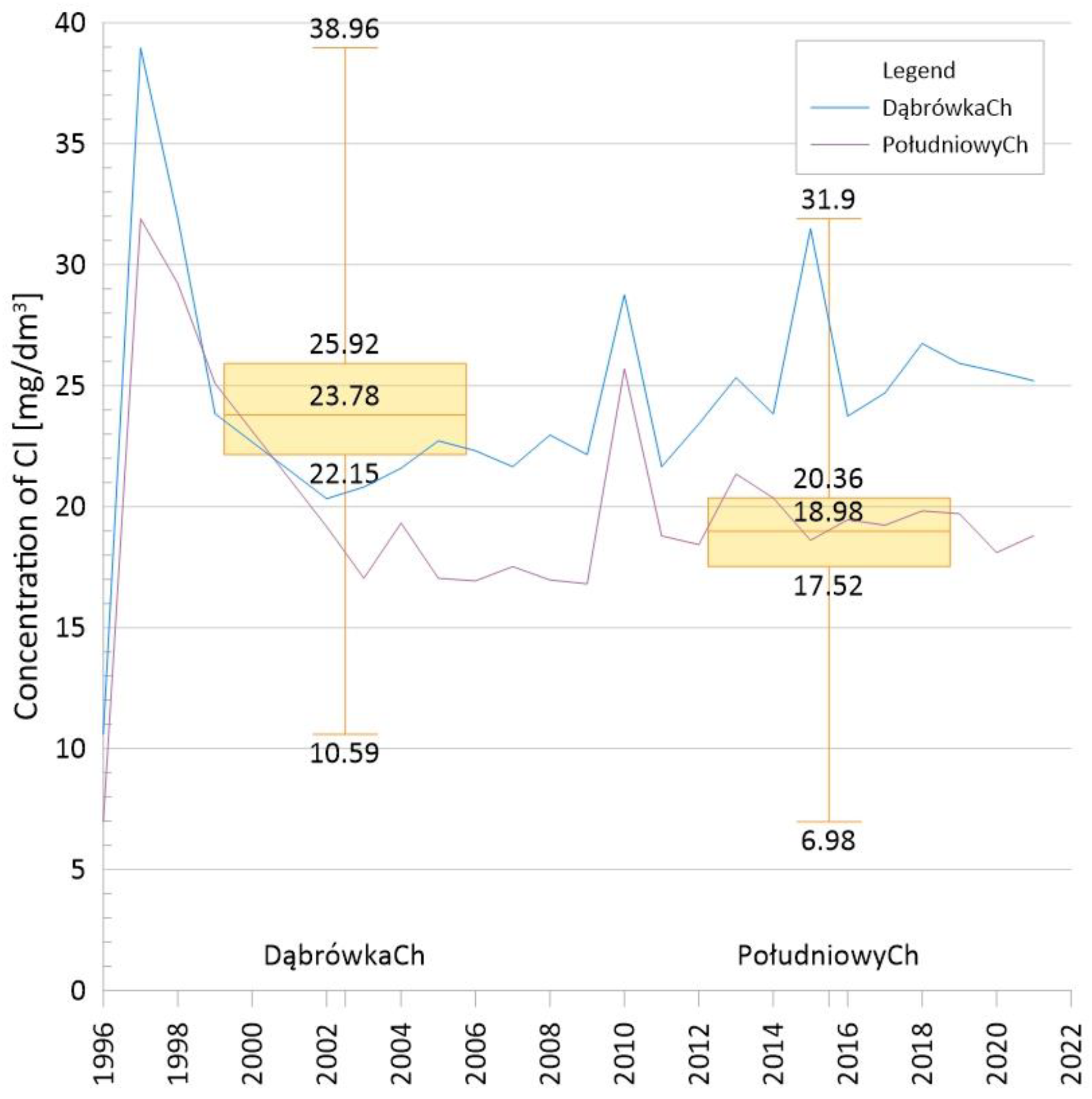
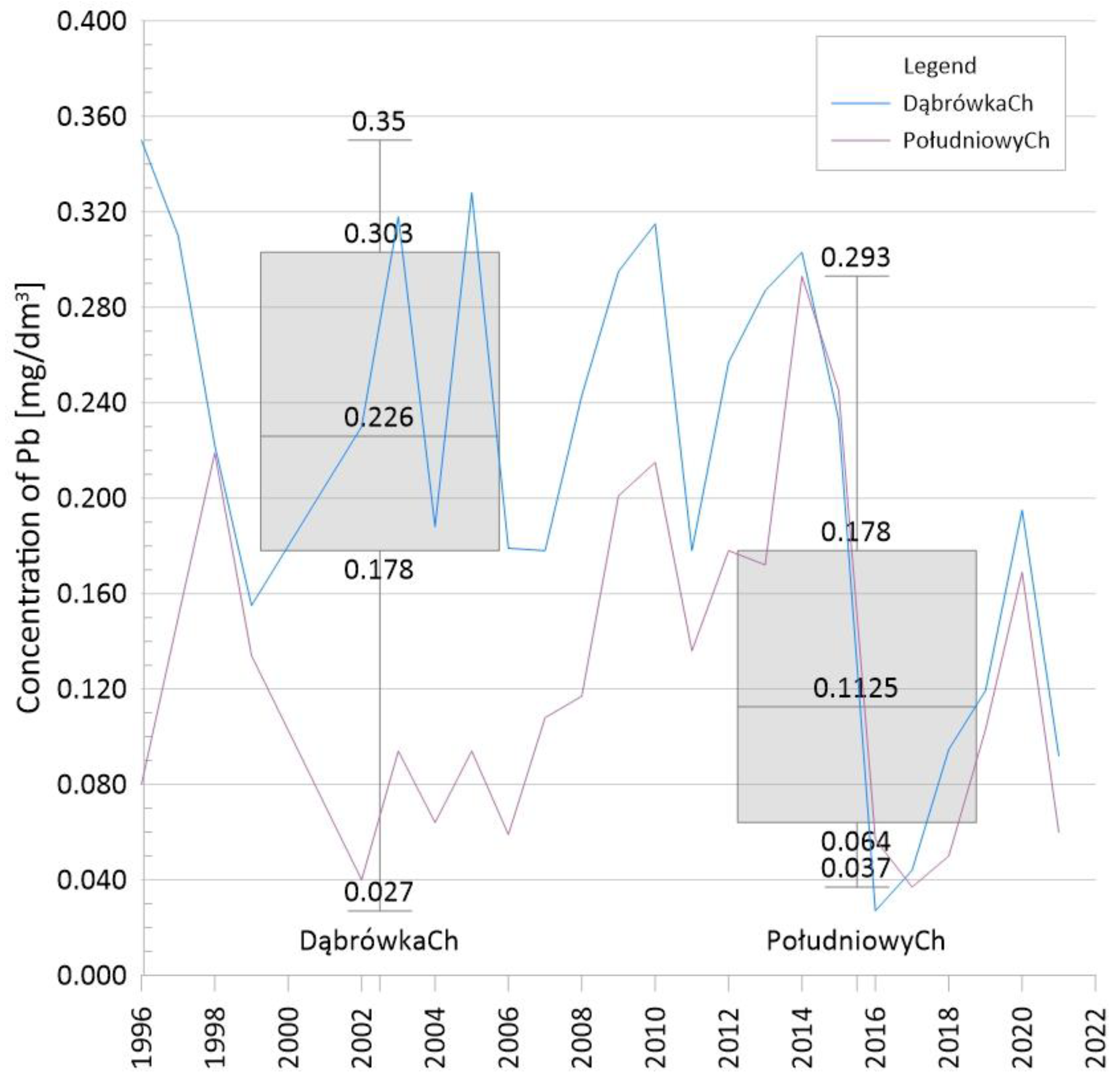
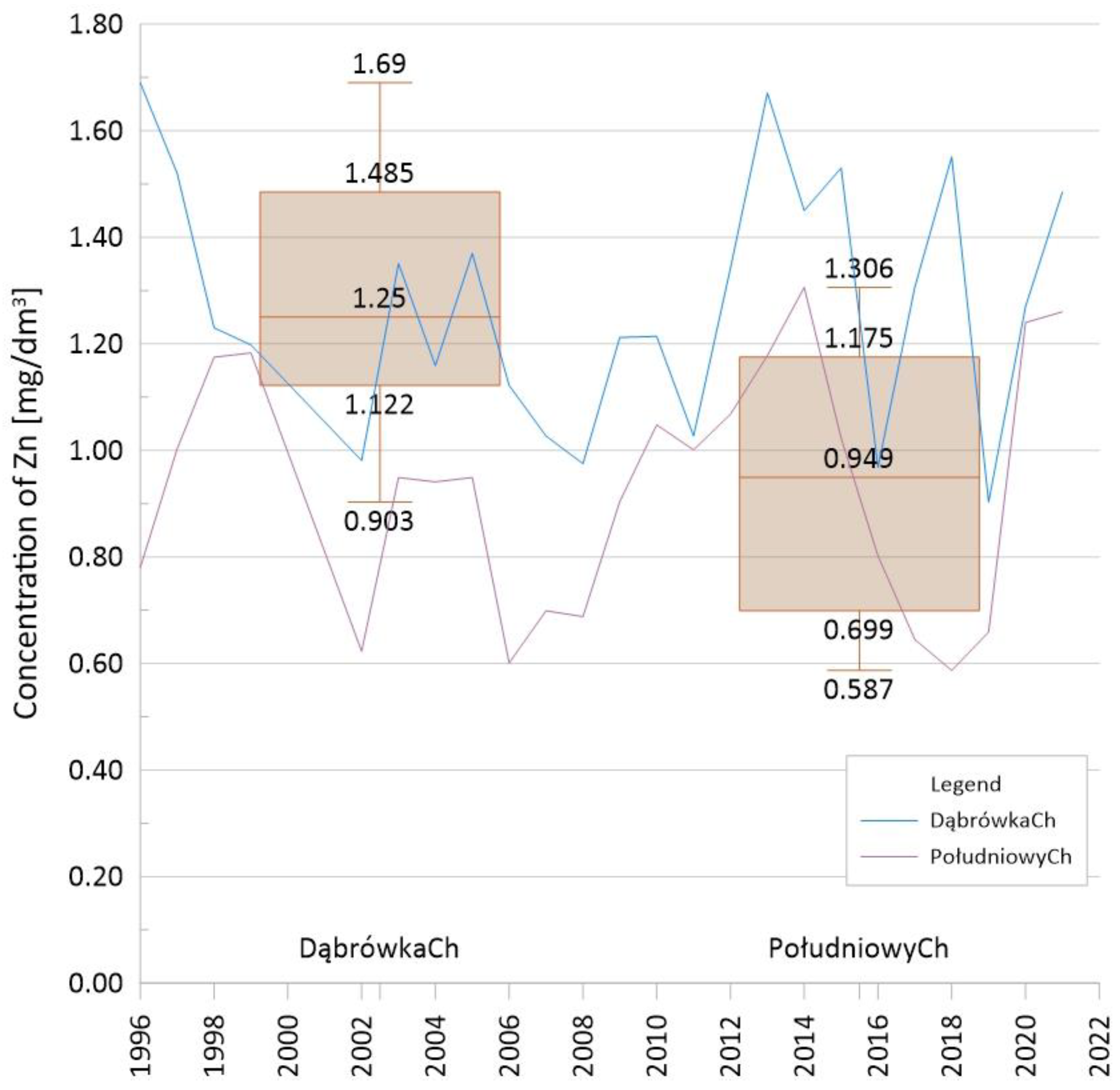
| Landscape Elements | Area in the Following Years (km2 (%)) | ||
|---|---|---|---|
| 1941 | 1961 | 2021 | |
| Water reservoirs | 0.95 (0.22) | 0.31 (0.07) | 0.42 (0.09) |
| Built-up areas | 9.51 (2.18) | 14.05 (3.22) | 25.92 (5.95) |
| Industrial areas | 2.08 (0.48) | 2.78 (0.65) | 7.92 (1.82) |
| Wastelands | 4.58 (1.05) | 4.15 (0.95) | 3.03 (0.70) |
| Arable land | 184.10 (42.23) | 187.33 (42.97) | 154.70 (35.48) |
| Wet meadows and peat bogs | 3.34 (0.76) | 6.60 (1.51) | 2.31 (0.53) |
| Meadows and pastures | 43.50 (9.98) | 34.12 (7.83) | 39.64 (9.09) |
| Forests and groups of trees | 162.80 (37.34) | 173.10 (39.70) | 191.87 (44.01) |
| Sands grasses | 25.10 (5.76) | 13.53 (3.10) | 10.16 (2.33) |
| Total area | 435.97 | 435.97 | 435.97 |
| Sum of watercourse lengths (km) | 278.10 | 328.10 | 299.20 |
| Research Period | 1950–1970 1 | 1950–1970 1 | 1950–1970 1 | 1975 3 | 1973–1975 2 | 1996–2020 5 | 2007–2012 4 |
|---|---|---|---|---|---|---|---|
| Sampling points | Drilling holes Q | Drilling holes J | Drilling holes T | Collective waters | Dąbrówka Channel/Południowy Channel | Dąbrówka Channel/Południowy Channel | Dąbrówka Channel/Południowy Channel |
| pH (−) | 6.0–8.5 (7.4) | 7.2–8.8 (7.8) | 6.0–8.5 (7.5) | No data | No data | (7.84–8.30)/(7.70–8.30) * | No data |
| SO4 (mg/L) | 13.9–218.9 (65.0) | 3.3–68.7 (26.6) | 16.5–206.0 (40.0) | 21.4–334.9 (50.1) | (74.4–118.3)/(41.3–42.9) * | (177.0–345.0)/(88.0–184.0) * | (290.0–324.0)/(114.0–131.0) * |
| Cl (mg/L) | 4.3–189.0 (22.5) | 5.3–41.5 (11.1) | 1.8–344.4 (14.1) | 3.3–36.2 (11.0) | No data | (10.59–38.96)/(6.98–31.90) * | (22.15–23.51)/(16.81–18.43) * |
| Zn (mg/L) | No data | No data | No data | 0.1–1.0 | −(1.7–2.3)/−(0.8–1.5) * | (0.903–1.690)/(0.587–1306) * | (0.975–1.342)/(0.688–1.068) * |
| Pb (mg/L) | No data | No data | No data | 0.05–0.10 | −(0.8–2.4)/−(0.1–0.8) * | (0.027–0.350)/(0.037–0.293) * | (0.243–0.295)/(0.108–0.201) * |
| Changes in Water Flows in Watercourses in the Initial Period of Reconstruction of the Groundwater Table | |
| 1 | Lack of water recharge to Biała Przemsza with mine water flowing through the Dąbrówka Channel through the Biała River; lack of water recharge to Sztoła through the Południowy Channel. |
| 2 | The flow in Biała Przemsza from the connection with Biała towards Sławków will be reduced by an estimated 70–80%; the recharge of mine water to Sztoła will cease and the river will dry up. |
| Changes in Water Flows in Watercourses in the Further Period of Reconstruction of the Groundwater Table | |
| 3 | The reconstruction of the groundwater table will take from several to several dozen years and will restore the natural flow of water in Biała Przemsza. |
| 4 | The initial springs of the Biała Przemsza River will appear, and the upper section of the river as well as the dried sections of the Biała Przemsza tributaries will be restored. |
| 5 | Increases in flows to the value of original flows: Biała Przemsza—Golczowice: 0.7–3.0 m3/s; Biała Przemsza—Sławków: 3–8 m3/s. |
Disclaimer/Publisher’s Note: The statements, opinions and data contained in all publications are solely those of the individual author(s) and contributor(s) and not of MDPI and/or the editor(s). MDPI and/or the editor(s) disclaim responsibility for any injury to people or property resulting from any ideas, methods, instructions or products referred to in the content. |
© 2023 by the authors. Licensee MDPI, Basel, Switzerland. This article is an open access article distributed under the terms and conditions of the Creative Commons Attribution (CC BY) license (https://creativecommons.org/licenses/by/4.0/).
Share and Cite
Różkowski, K.; Różkowski, J.; Rahmonov, O. The Historical Aspect of the Impact of Zn and Pb Ore Mining and Land Use on Ecohydrological Changes in the Area of the Biała Przemsza Valley (Southern Poland). Land 2023, 12, 997. https://doi.org/10.3390/land12050997
Różkowski K, Różkowski J, Rahmonov O. The Historical Aspect of the Impact of Zn and Pb Ore Mining and Land Use on Ecohydrological Changes in the Area of the Biała Przemsza Valley (Southern Poland). Land. 2023; 12(5):997. https://doi.org/10.3390/land12050997
Chicago/Turabian StyleRóżkowski, Kazimierz, Jacek Różkowski, and Oimahmad Rahmonov. 2023. "The Historical Aspect of the Impact of Zn and Pb Ore Mining and Land Use on Ecohydrological Changes in the Area of the Biała Przemsza Valley (Southern Poland)" Land 12, no. 5: 997. https://doi.org/10.3390/land12050997
APA StyleRóżkowski, K., Różkowski, J., & Rahmonov, O. (2023). The Historical Aspect of the Impact of Zn and Pb Ore Mining and Land Use on Ecohydrological Changes in the Area of the Biała Przemsza Valley (Southern Poland). Land, 12(5), 997. https://doi.org/10.3390/land12050997





